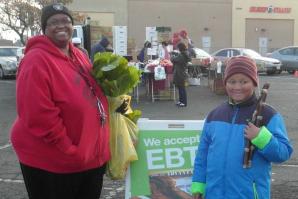
Regina Vasquez ended up homeless after her father, whom she had been caring for, passed away in 2009. Embarrassed by incontinence caused by Crohn’s disease, she found living out of her car a more dignified alternative to life in a public shelter. So she would park her 1992 Cadillac Eldorado outside 24-hour grocery stores or fast food joints for easy bathroom access. She spent her days wracked with worry over her next meal, her next accident, the next time her condition would inevitably drive her to Sutter General’s emergency department, and whether she would need yet another surgery. Vasquez estimates she made six to eight visits to emergency rooms per year during her time on the streets.
“I was really ashamed, and I didn’t want to be a burden on anyone, even if it was someone I grew up with,” she says. “I felt ashamed that I was homeless and in that condition.”
Vasquez isn’t an anomaly. Homeless and low-income individuals frequently use expensive emergency departments for issues better addressed, and potentially prevented, by primary care and behavioral health professionals. Prompted by this heavy use, outreach programs are implementing proactive strategies to break the cycle for good.
“This is home to them,” says Medua Odum, one of WellSpace Health’s ED navigators who works with frequent users of Sutter General and Memorial emergency departments. “It’s familiar, and they know they’re going to get taken care of here.”
WellSpace Health and Sacramento Steps Forward are employing tactics that have proven successful in diverting patients like Vasquez from the emergency department and connecting them with services that will enable them to live healthier lifestyles off the streets. WellSpace Health, a federally qualified health center offering primary care, pediatric dental and integrated behavioral health services to underserved populations, has a series of programs that address unsheltered populations. Now, Sacramento Steps Forward, a local nonprofit that acts as a unifying body for service providers throughout the county, is launching its Common Cents program using strategies similar to those WellSpace has found effective.
A 2002 study by the University of California San Francisco found that homeless individuals use emergency departments three times more often than the general population. Holly Harper, regional community benefits manager for Sutter Health Sacramento Sierra Region, estimates the base cost of each emergency room visit is $1,000. And with the introduction of the Affordable Care Act, emergency departments are seeing a flood of people who don’t know where to go for care. The Colorado Hospital Association found that hospitals in states that expanded Medicaid under the ACA saw a 5.6 percent increase in ED visits between 2013 and 2014, compared to only 1.8 percent in nonexpansion states.
Vasquez’s ED boomerang cycle stopped when she was referred to one of Wellspace Health’s ED navigators, who are embedded in emergency departments at Sutter General and Sutter Memorial. These navigators work first with hospital staff to identify frequent users of expensive emergency department services, then meet with patients to figure out what’s causing their repeated visits and help them access resources that will elevate their health and quality of life.
Vasquez ended up receiving a referral to WellSpace’s T3 Program (Triage, Transport and Treat), which provides intensive case management. A case manager helped her access financial resources through Social Security and procure housing. WellSpace doctors helped her reduce the number of medications she was on and taught her how to change her colostomy bag. Since connecting with WellSpace, Vasquez has not had a single visit to the emergency room.
Sutter reports an 85 percent decrease in hospital recidivism among T3 patients like Vasquez. During the first three quarters of 2014, Sutter ED navigators connected with 263 patients, made an average of 13.5 referrals per patient to services, including primary and mental health care, insurance resources, food banks, housing and transportation, and enrolled 116 patients in their T3 program.
The best practices implemented by WellSpace are part of what is informing Sacramento Steps Forward’s Common Cents Program, which will launch in January. The program seeks to reduce high-cost alternatives like emergency health care by bringing together housing and a broad array of services already available in the community.
“When you’re worried about what you’re going to eat or where you’re going to sleep, you’re not going to prioritize your doctor’s appointment or getting into substance abuse treatment.” Jodi Nerell, director of behavioral health services, WellSpace Health
The reason Wellspace Health is able to make such an impact on the homeless population can be broken down into three parts:
Meet Individuals Where They Are
Whether it’s because they’ve been traumatized by a system that’s broken or simply due to a lack of awareness, the unsheltered population won’t always use available services. Because of the high rate at which homeless and low-income individuals use emergency departments, and given that Wellspace Health is a health center, emergency departments are a great place for employees to first make contact with those who may unnecessarily overuse the hospital’s resources. For Vasquez, it was her only point of entry to the system.
Common Cents will deploy outreach workers to geographical areas found to have a high rate of mortality among the homeless population, including the central city, Oak Park and along public transportation routes.
Focus on Housing First
“When you’re worried about what you’re going to eat or where you’re going to sleep, you’re not going to prioritize your doctor’s appointment or getting into substance abuse treatment,” says Jodi Nerell, director of behavioral health services at WellSpace Health.
Nerell says that while a small portion of the population isn’t ready to come indoors, most individuals require only some sense of basic stability and safety before they are ready to unpack and investigate issues related to mental and physical health or substance abuse.
ED navigators offer housing information to interested patients, and T3 case managers transport them to housing intakes and help with paperwork.
Common Cents will contract with Sacramento Self Help Housing for a minimum of 20 interim housing units for people awaiting more permanent housing placement.
Offering Individualized Care
While WellSpace Health does not require individuals in its housing units to use supportive services, many resources are available onsite. At Vasquez’s housing complex on Stockton Boulevard, a doctor visits twice a week. There are exam rooms, and every other Friday there are drop-offs from a food bank. Case managers go so far as to drive residents to the DMV or Social Security office, or sit in on doctor’s appointments. According to Amber Salazar, who runs WellSpace’s health care access and case management program, it’s important that individuals are allowed to craft their own treatment plan with the support of a case manager.
“What’s appropriate for one person may not be appropriate for another,” she says. “That’s key to engaging with the client and maintaining a relationship. You have to come from a very respectful place.”
To meet the array of needs of all the individuals they encounter, outreach workers with Common Cents will come from a variety of backgrounds.
“Outreach has a lot of subpopulations,” says SSF executive director Ryan Loofbourrow. “For example, we’ve found that veterans respond better if it’s a veteran that is the outreach worker. It’s important that we’re looking at who the outreach worker is and what the need is.” He also plans to use existing relationships between bike cops and homeless adults, as well as Wind Youth Services, which works with homeless youth.
Common Cents will also pilot a common assessment software tool that will allow outreach workers to get people into a system accessible to all service providers. While the current tool targets chronically homeless and homeless veterans, there are plans to add assessment tools geared toward youth and families.
“The idea is that through the assessment we get a list of programs they are eligible for, and whittle it down to what’s available,” says Michele Watts, deputy director for SSF. “From there, it’s about what the participant wants, driven by where they are located, where they want to be located, past experiences — offering them some choice from that list after the assessment is complete.”
Vasquez calls the T3 program a godsend. January will mark three years since she moved out of her car and into housing. She’s gotten her medical condition under control to the extent that she now enjoys a more active lifestyle. She has a gym membership, rides her bike and enjoys walks with her 2-year-old Chihauhua, Bubbles.
“There’s so many good things to say about WellSpace and the case managers,” she says. “I’m so very thankful for this program. To me, it’s been a miracle.”
As Sacramento Steps Forward prepares to roll out Common Cents, for individuals struggling like Vasquez did, perhaps there is even more help on the way.
Recommended For You

Under One Roof
Can rapid rehousing save local homeless families from life on the streets and in shelters?
Though a new rapid rehousing initiative may stymy the troubling trend locally, some providers remain concerned that a lack of mandatory supportive services and intensive case management may cause the program to exacerbate, not eliminate, the problem.

Seen & Not Heard
Child advocates could fundamentally shift foster care outcomes, if only there were more volunteers
Over half a million kids live in foster care in the U.S. as a result of abuse, neglect or abandonment. Because they can’t advocate for themselves, many become victims a second time, lost in an overburdened child welfare system that can’t pay close attention to each child. But one program is drastically improving outcomes for foster youth, despite the overwhelming odds.

Healthy Options
Farmers markets and urban growers combat local food deserts
Despite living near some of the most productive farmland on earth, many Sacramentans are unable to find produce that’s both fresh and affordable in their own neighborhoods.





Comments
Hi my name is Tori Harrison and I really enjoyed your story and was needing help myself, I'm currently homeless with a male child over 10 Wich means no shelter will accept you...NONE OF THEM... also just had cancer removed from my left temple, and have to go back in October to have more removed, also have severe rheumatoid arthritis and last but not least plaque psoriasis. So with my health like it is and to have my 13 year old son sleeping in my car is not fun. I need to get in this mercy housing apartment I talked to the office lady she said get ahold of well space navigator. Well these people don't seem to know what I'm talking about..please if someone has any information p!ease text or email 9168462907..please..I need well space navigator ..thanks